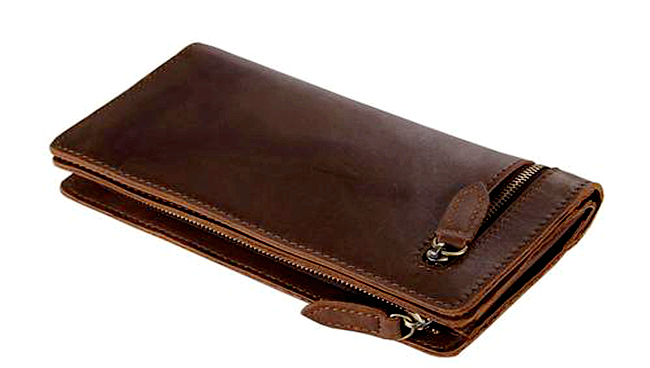Taken it’s where we keep our cash, the fact that most men choose a leather wallet so casually, and so haphazardly, remains a sartorial mystery.
A few thoughtful souls may ponder the colour of the leather, or the number of available pockets, but we often overlook the fact that a wallet is a defining accessory in itself, with its own distinctive look, feel and leathery smell.
Follow this guide, and you’ll never look at wallets in the same light again.
The style
Although all wallets have the same basic purpose, there are a variety of wallet styles to choose from, and the utility and benefits of each style should be examined carefully:
The Billfold
The classic wallet, also called the bifold, which folds in half with card compartments on either side. Your unfolded cash bills go in the rear pocket. The best billfolds are sleek and simple, and fit into your trouser pocket without creating a bulge.
The Zip-around
A little unorthodox, but it makes a statement. A zip-around wallet brings extra security and usually contains multifunctional compartments for loose coins. Be extra careful when choosing the size of this wallet; the zipper goes all the way around the edge of the wallet and can sometimes add bulkiness.
The Breast
Designed to hold bank notes without creasing or folding,the slim breast wallet boasts an air of sophistication (Cary Grant swore by them). With room for only the core essentials, they should be carried in your breast pocket and, once again, the slimmer the wallet the less it will intrude upon your suit’s silhouette.
The Card Holder
The wallet’s minimalist cousin, this is an elegant alternative for our increasingly cashless society when only credit cards are required. Generally speaking, card holders are designed for carrying cards, but not bank notes or coins.
The materials
Once you’ve picked a style that suits your needs, the next consideration is the wallet’s materials. It all comes down to the leather and the construction.
Firstly, be careful of inexpensive imitations. Low-quality material like corrected grain leather is sanded to remove imperfections and then coated with a varnish, which makes it plastic-y to the touch. These wallets should be avoided.
Instead, look for wallets that have been made with vegetable-tanned calf leather or full-grain leather. These come from a higher quality hide, and no sanding has occurred. They will also develop a patina over time, whereby the leather deepens with a rich, graceful colour.
“For high-end leather goods, you are looking for hides and skins that need to be perfect and without blemishes and imperfections,” says Mark Lightfoot, founder of Cavesson’s. “You pay more for this grade of leather, but it is worth it.”
As far as construction goes, there are two main types for wallets — turned or cut edge. With a cut edge, the leather will be cut and stitched together leaving the raw edge exposed, which will often be coated with resin.
Turned edge wallets will have thinner edges, which have been turned over before being stitched into place. This is a more expensive process, but the result is a more robust edge that will last longer. It’s the little things that matter.
The contents
Men’s wallets have a habit of becoming black holes, sucking in anything and everything, so it’s important to consider what you actually need to put inside them. Obviously, you’re going to require your ID, cash, and your bankcards. But what else? As a rule of thumb, if you don’t use it every day then make life easier by not putting it in your wallet. Driver’s licence? Of course. Barbershop discount card? Hardly.
The goal is to keep your wallet effortlessly functional. Anything made of paper — cheap business cards, receipts, coupons — will degrade quickly and cause excessive bulking. Likewise, password cheat sheets, blank cheques and (perish the thought) a spare set of keys are highly sensitive items that belong elsewhere.
What to avoid PU leather
Polyurethane is the most widely-used material in fake leather wallets. Despite being listed as ‘PU leather’, polyurethane contains no animal hide at all. PU wallets appear to have an artificial sheen. They age quickly and are highly susceptible to wear and tear.
Patent leather
Patent leather wallets consists of thin leather which has been coated with a shiny lacquer-like finish, stripping them of any character. Such wallets fall easy victim to cracks and splits.
Genuine’ leather
A popular high street phrase that sounds like an assurance of quality, but is almost meaningless. ‘Genuine’ leather can refer to any number of undesirable materials like bonded leather (scraps of hide glued together) or patent leather. Tellingly, a ‘genuine’ leather wallet never develops a patina.
Post time: Dec-29-2019


